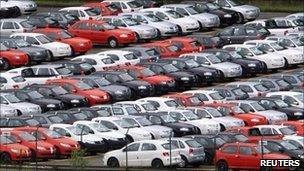Brazil raises interest rates to 11.75%
- Published

Manufacturers in Brazil are already struggling to cope with an overvalued currency
Brazil's central bank has raised its key interest rate to 11.75% in a bid to hold down inflation in one of the world's fastest-growing economies.
The rise, from 11.25%, is the second half-point increase since the start of the year.
It is also the second under President Dilma Rousseff and central bank head Alexandre Tombini, both of whom took office in January.
Inflation was 5.91% last year and is forecast to remain above 5% in 2011.
The rate rise came on the same day as news of a modest rebound in Brazilian industrial production, which increased by 0.2% in January from the previous month.
This was far better than the consensus forecast of a 0.7% decline and came after a 0.8% month-on-month decline in December.
Currency headache
Although the rate rise may help to curb inflation, it risks sucking in foreign money, increasing upward pressure on the already overvalued Brazilian real.
Capital inflows from outside Brazil have soared as investors flee record-low rates in more developed countries.
The strengthening of the real has hit Brazil's manufacturers hard because their exports have become more expensive.
"Despite the improving picture for industry in the very latest data, the bigger picture is that manufacturers are still struggling to live with the effects of a stronger currency," said Neil Shearing, senior emerging markets economist at Capital Economics.
Last month, in another effort to stop the economy overheating, the government said it would implement 50bn reais ($30bn; £19bn) of spending cuts.
But Brazil should do more to rein in a massive consumer credit boom that has helped fuel the economy's rapid expansion, analysts say.
Mr Shearing at Capital Economics said the government needed further fiscal tightening to ensure more balanced growth.
"This, in turn, will require a radical, and politically very difficult, overhaul of the public finances that goes well beyond the 50bn reais of spending cuts that were recently announced," he said.
The Brazilian economy, Latin America's largest, grew more than 7% in 2010 and is expected to grow between 4.5% and 5% this year.
Other anti-inflation measures have included a big increase in banks' reserve requirements to hold back lending.
- Published19 January 2011
- Published27 October 2010
- Published20 October 2010